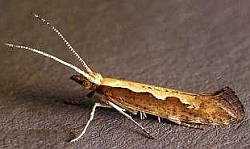
Decoding of Diamondback Moth's (DBM) genome sequence will help in its pest management
Singapore: An international research consortium, led by Fujian Agriculture, Forestry University (FAFU) and Beijing Genomics Institute (BGI), China, has completed the first genome sequence of the Diamondback Moth (DBM) (scientifically called as Plutella xylostella), the most destructive pest of brassica crops. This work provides wider insights into insect adaptation to host plant and opens new ways for more sustainable pest management. The study was published online in Nature Genetics.
In this study, researchers sequenced the genome of DBM by whole genome shotgun (WGS) and fosmid clones technologies, yielding aound 343 Mb draft genome with 18,071 predicted protein-coding genes. Compared with other sequenced insect species, they found that the diamondback moth possesses a relatively larger set of genes and a moderate number of gene families, suggesting the expansion of certain gene families.
Additionally, the genome-based phylogeny demonstrated that DBM was a basal lepidopteran species, which is well supported by its modal karyotype. Based on the genomic data generated from around 1,000 male pupae, researchers identified the genome-wide level of polymorphism within the sequenced DBM strain (Fuzhou-S), which may lay the genetic bases for DBM in adapting to various environmental challenges.
They investigated a set of genes preferentially expressed at the larval stage that contribute to odorant chemoreception, food digestion and metabolic detoxification. Interestingly, they found that the co-expression of sulfatase modifying factor 1 (SUMF1) and glucosinolate sulfatase (GSS) genes may be crucial for DBM to become a successful cruciferous herbivore.
Insecticide tolerance or resistance may have contribution to the option of detoxification pathway in insect herbivores. In this study, researchers found DBM has a larger set of insecticide resistance-related genes than silkworm (Bombyx mori) that had little exposure to insecticide over 5,000 years of domestication.
They identified in DBM obvious gene duplications of four gene families that participated in xenobiotic detoxification in insects, including ATP-binding cassette (ABC) transporter families, the P450 monooxygenases (P450s), glutathione S-transferases (GSTs) and carboxylesterase (COEs).
Notably, the further analysis highlighted the potential role of ABC transporters in detoxification.The moth preferentially feeds on economically important food crops such as rapeseed, cauliflower and cabbage.
It has developed resistance to against more than 50 insecticides, including DDT and Bt toxins, among others, and this has rendered the use of chemicals ineffective. It is estimated that the total cost associated with the damage and management of the pest is estimated to be $4-to-5 billion per year worldwide.
"The completed genome sequencing of DBM will lay a solid foundation for tracking the evolutionary mechanisms of how an insect evolves to become a successful herbivore that can defense many insecticides." said Professor Minsheng You, vice president of FAFU and leader of the research team. "The work here also provides an invaluable resource for scientists to better understand the reasons why DBM is such a serious pest and how new strategies can be developed to control insect pests."




